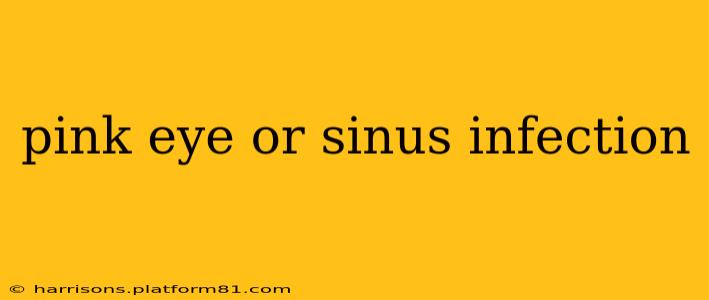Pink eye, also known as conjunctivitis, and sinus infections are both common ailments that can cause discomfort and affect your eyes and face. While they share some overlapping symptoms, understanding the key differences is crucial for proper diagnosis and treatment. This guide will help you differentiate between pink eye and a sinus infection, addressing common questions many people have.
What are the symptoms of pink eye?
Pink eye is an inflammation or infection of the conjunctiva, the membrane that lines the inside of your eyelids and covers the white part of your eye. Symptoms typically include:
- Redness: The whites of your eyes appear red or pink.
- Itching: Intense itching is a common symptom.
- Discharge: A watery, mucus-like, or pus-like discharge may be present. This discharge can sometimes crust the eyelids shut overnight.
- Burning or stinging: A burning or stinging sensation in the eyes is frequently reported.
- Sensitivity to light: Bright lights may be uncomfortable.
- Swollen eyelids: The eyelids may appear swollen.
It's important to note that pink eye can be caused by viral, bacterial, or allergic reactions. Bacterial pink eye often presents with thicker, pus-like discharge, while viral pink eye typically has a watery discharge. Allergic conjunctivitis is usually accompanied by significant itching.
What are the symptoms of a sinus infection?
A sinus infection, or sinusitis, is an inflammation or infection of the sinuses—air-filled spaces behind your forehead, cheeks, and nose. Symptoms can vary but often include:
- Facial pain or pressure: This is a key indicator, often felt in the forehead, cheeks, or around the eyes.
- Congestion: A stuffy nose is a prominent symptom.
- Headache: Sinus infections frequently cause headaches, often accompanied by pressure.
- Fever: A fever may be present, particularly in bacterial infections.
- Thick nasal discharge: The discharge is typically thick, colored (yellowish or greenish), and may be accompanied by postnasal drip.
- Cough: A persistent cough can result from postnasal drip.
- Fatigue: Sinus infections can lead to overall tiredness and fatigue.
How can I tell if it's pink eye or a sinus infection?
Differentiating between pink eye and a sinus infection can be challenging as some symptoms overlap (like facial pressure and headache). However, the key distinctions lie in the primary location of symptoms and the type of discharge:
- Pink eye primarily affects the eyes: Redness, itching, and eye discharge are the prominent symptoms. Facial pain is typically absent or mild.
- Sinus infections primarily affect the sinuses and nose: Facial pain or pressure, congestion, thick nasal discharge, and headaches are the dominant symptoms. Eye symptoms are usually secondary or minimal.
If you experience significant eye redness, itching, and discharge without prominent facial pain or pressure, pink eye is more likely. Conversely, if you experience facial pain, pressure, congestion, and thick nasal discharge with minimal eye symptoms, a sinus infection is more probable.
Can you have both pink eye and a sinus infection at the same time?
Yes, it is possible to have both pink eye and a sinus infection concurrently. Viral infections, for example, can affect multiple areas of the body. If you suspect you have both, it's crucial to consult a doctor for proper diagnosis and treatment.
When should I see a doctor for pink eye or a sinus infection?
You should seek medical attention if:
- Your symptoms are severe or worsen.
- You experience vision changes.
- You have a fever.
- Your symptoms persist for more than a week.
- You have a compromised immune system.
What are the treatments for pink eye and sinus infections?
Treatment for both conditions depends on the underlying cause. Bacterial pink eye might require antibiotic eye drops, while viral pink eye typically resolves on its own with supportive care. Sinus infections may require antibiotics, depending on the severity and suspected cause. Over-the-counter pain relievers and nasal sprays can help manage symptoms for both conditions. Always consult a healthcare professional for proper diagnosis and treatment.
This information is for educational purposes only and should not be considered medical advice. Always consult a doctor or other qualified healthcare professional for diagnosis and treatment of any medical condition.
